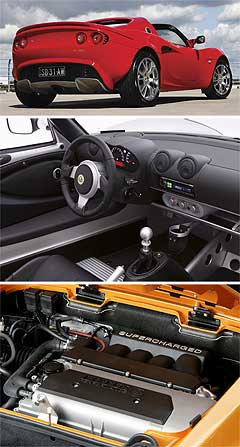New models - Lotus - Elise - SC convertibleFirst drive: Blown Elise is one rapid Lotus roadsterCracker: Elise SC sprints to 100km/h in a giant-killing 4.6 seconds. Lotus blows in with its fastest Elise roadster ever, the brisk new supercharged SC25 Apr 2008 LOTUS Cars has created its fastest ever Elise with the help of a supercharger. Launched in Australia this week, the boosted version of Lotus’ open-top sportscar – known simply as the Elise SC – sits at the top of the Elise range, priced from $104,990. It joins the $69,990 100kW 1.8 S and the $94,990 141kW 1.8 R. The Elise SC generates 15 per cent more power and 17 per cent more torque than the high-revving R engine for totals of 163kW and 212Nm. All three engines are based on the ZZ-series engine produced by Toyota. Naturally aspirated versions of these powerplants served in the discontinued Celica, MR2 and Sportivo Corolla. The Elise SC engine is based on the same 2-ZZ VVTL-i 1.8 as the Elise R.  It would be easy to assume that the boosted engine behind the seats in the Elise SC is the same as the supercharged version of the Toyota engine that powers the ballistic Exige S hard-top. It would be easy to assume that the boosted engine behind the seats in the Elise SC is the same as the supercharged version of the Toyota engine that powers the ballistic Exige S hard-top.The Exige S uses an intercooler and an Eaton bolt-on rotor pack (M62), while the Elise SC has no intercooler and uses a Lotus-designed Magnuson supercharger with a smaller rotor pack (M45) which is coupled with the custom intake manifold plenum as part of a single-piece casting. The power figure is the same for both engines, but there is a slight difference when it comes to torque. The Elise SC generates its 212Nm at 5000rpm, while the Exige S pumps out 215Nm at 5500rpm. There are also some differences when it comes to power delivery. Lotus claims the Elise SC engine has been engineered to be more progressive. The variable camshaft change point is not set at a single point it can switch over between 4000rpm and 6200rpm depending on the way the engine is being used. Lotus has also given the Elise SC softer throttle response for what it describes as a “more refined” driving experience because it believes this car is more likely to be used on the road than the raw Exige S. So why did Lotus spend all that time and money bothering to run a different supercharger set-up? Part of the reason for not using an intercooler relates to visibility, as the plastic intercooler ducting obscures all rear window vision in the Exige S. The other reason likely to have carried more weight is the fact that the intercooled engine simply would not fit, without modification, in the back of the Elise. Another benefit of doing away with the intercooler and all the associated plumbing is a weight reduction of 8kg. That is important for a company like Lotus where less is always best. The Elise SC tips the scales at just 870kg. Combined with the power of forced induction, the light kerb weight contributes toward performance figures that belong to far more expensive supercars. Lotus claims the Elise SC can sprint from 0-100km/h in just 4.6 seconds. It can manage 0-160km/h in 10.7 seconds and runs all the way to a top speed of 241km/h. The last figure most Lotus customers would think of is the fuel consumption number, but it is actually very impressive given the performance. Running to the ADR combined cycle test, the Elise SC uses 8.5L/100km, which beats all large six-cylinder family sedans and several mid-sized cars. A six-speed manual driving the rear wheels only is the only transmission option. Just like other Lotus cars, the Elise SC uses an extruded and bonded aluminium chassis, with a steel subframe. All up, this chassis weighs just 68kg. Braking power is provided by two-piston AP Racing callipers at the front and single-piston Brembo callipers at the rear, which all latch onto 282mm vented and cross-drilled discs. It does run an ABS system, although it is set up differently to most road cars. Lotus says the system is set-up for sporty driving and is so subtle that most drivers will not realise it is working. One of the ways that Lotus lovers will be able to pick the Elise SC from its siblings is by looking at the wheels. The SC has 17-inch alloy wheels with a unique six-spoke design. They are half an inch wider and now measure eight inches across and run specific Yokohama AD07 LTS 225/45 R17 tyres. The other visible difference is a rear-mounted spoiler. Inside, the Elise SC picks up the new MY08 instrument cluster which gives more information about the vehicle. There is also a new engine immobiliser. The SC comes with the same standard equipment as the Elise R including dual front airbags, air-conditioning, CD stereo and cloth-covered Probax sports seats. Two option packs are available for the Elise SC. The $8000 Touring pack includes leather Probax seats, driving lights, sound insulation panelling, an aluminium cup holder, full carpet, and a leather-trimmed centre console and handbrake lever. A $7000 Sport pack includes Bilstein sports dampers, Lotus switchable traction control, twin oil coolers, seven-spoke lightweight forged wheels with AD07 tyres and Probax sports seats with holes for racing seatbelts. Quick testsElise pricing
Motor industry news |
|















Facebook Twitter Instagram